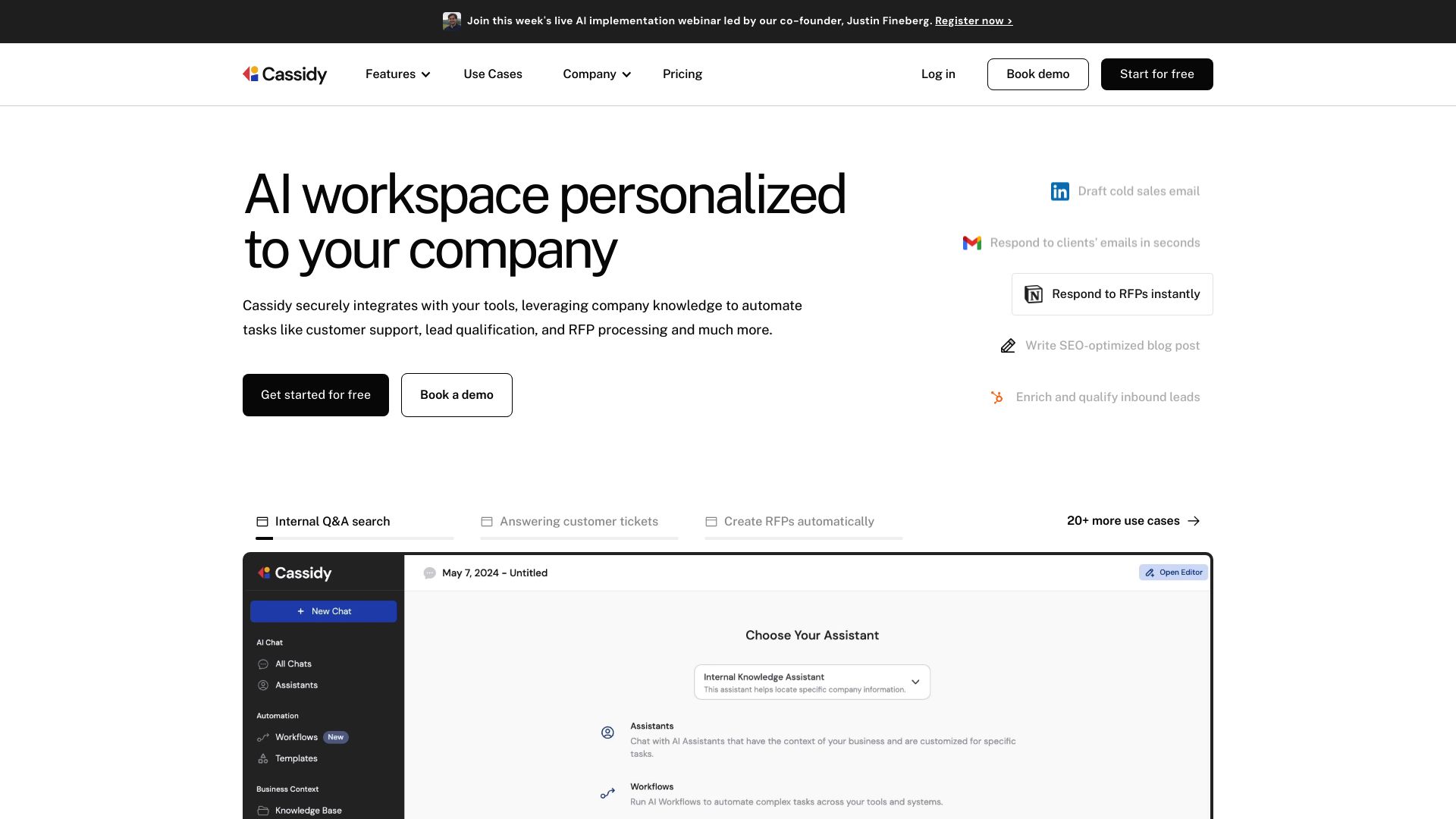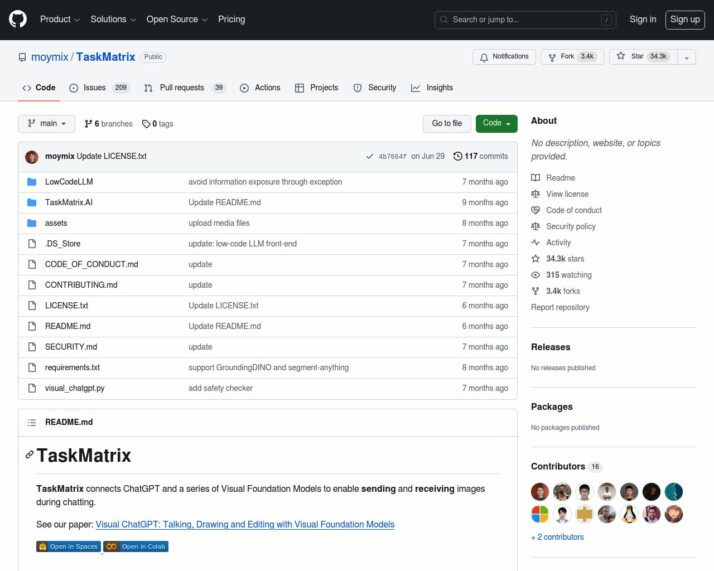Cassidy vs. TaskMatrix: AI Platforms Compared
AI agent development platforms reshape how businesses harness artificial intelligence. Cassidy vs. TaskMatrix, and SmythOS each offer unique approaches to creating and deploying AI solutions. Cassidy empowers non-technical users with its no-code workflow builder and enterprise-grade security.
TaskMatrix connects foundation models to specialized APIs, enabling complex task execution across digital and physical domains. SmythOS combines ease of use with advanced features, offering unparalleled flexibility in deployment options. This comparison explores how these platforms stack up in key areas like usability, integration capabilities, and security measures, helping you choose the right tool for your AI development needs.
Cassidy Overview
Cassidy empowers businesses to create customized AI assistants and workflows tailored to their specific needs. The platform integrates seamlessly with existing tools, leveraging company knowledge to automate tasks like customer support, lead qualification, and RFP processing.


Cassidy’s no-code workflow builder allows users to design complex AI automations through an intuitive drag-and-drop interface. This visual approach enables non-technical users to create sophisticated AI solutions without programming skills. The platform supports integration with various data sources, including Google Drive, Slack, and Notion, ensuring AI assistants have comprehensive context for each business.
Cassidy’s no-code workflow builder allows users to design complex AI automations through an intuitive drag-and-drop interface. This visual approach enables non-technical users to create sophisticated AI solutions without programming skills.
Security stands out as a key feature of Cassidy’s offering. The platform implements enterprise-grade security measures to protect sensitive data, ensuring it’s never used for model training. This commitment to data privacy makes Cassidy suitable for businesses handling confidential information.
Cassidy adopts a model-agnostic approach, allowing users to leverage any foundational AI model. This flexibility future-proofs AI strategies, enabling businesses to adapt as new models emerge. The platform also offers browser extensions, bringing AI capabilities directly into web applications like LinkedIn and email clients for seamless integration into existing workflows.
While Cassidy excels in many areas, it lacks some advanced features found in other platforms. The absence of a dedicated debug mode for troubleshooting workflows and AI assistants may pose challenges for users seeking to fine-tune their solutions. Additionally, Cassidy doesn’t explicitly support multimodal inputs, potentially limiting its applicability in scenarios requiring diverse data types.
TaskMatrix Overview
TaskMatrix.AI revolutionizes AI integration by connecting general-purpose foundation models with specialized APIs. Developed by Microsoft, this open-source ecosystem enhances the capabilities of models like GPT-4, enabling them to perform a wide range of digital and physical tasks.


The platform’s core strength lies in its ability to understand user instructions, generate executable action codes, and leverage appropriate APIs to complete complex tasks. TaskMatrix.AI features a comprehensive API repository, an intelligent API selector, and an action executor, forming a powerful triad that bridges the gap between diverse AI models and real-world applications.
TaskMatrix.AI revolutionizes AI integration by connecting general-purpose foundation models with specialized APIs… enhancing the capabilities of models like GPT-4, enabling them to perform a wide range of digital and physical tasks.
TaskMatrix.AI excels in its versatility, offering solutions for office automation, robotics, and Internet of Things (IoT) integration. Its modular design allows for seamless incorporation of both foundation models and specialized APIs, making it an ideal choice for developers seeking to create custom AI solutions or businesses looking to enhance their operations with advanced AI capabilities.
While TaskMatrix.AI offers impressive features, it may present a steeper learning curve for non-technical users compared to some other platforms. Its focus on API integration and custom model creation caters more to developers and AI enthusiasts, potentially limiting its immediate accessibility for business users seeking no-code solutions.
TaskMatrix provides a robust framework for AI development, including access to pretrained models, API connectors, and an extensive resource library. This combination of tools and resources positions TaskMatrix.AI as a powerful platform for those looking to push the boundaries of AI integration and automation across various domains.
Feature Comparison
TaskMatrix and Cassidy offer distinct approaches to AI agent development, with key differences in their core components and security features. TaskMatrix excels in connecting general-purpose foundation models with specialized APIs, enabling a wide range of digital and physical tasks. Its modular design allows seamless incorporation of both foundation models and APIs, making it ideal for developers seeking custom AI solutions. However, TaskMatrix lacks some user-friendly features that Cassidy provides.
Cassidy emphasizes ease of use with its no-code workflow builder and visual interface, catering to non-technical users. It offers robust integration capabilities with existing business tools and data sources, enhancing its appeal for enterprise users. Cassidy also prioritizes data security, implementing enterprise-grade measures to protect sensitive information. However, it falls short in some advanced features that TaskMatrix offers, such as multimodal support and extensive API integration.
In terms of security, Cassidy’s enterprise-grade encryption and data protection measures give it an edge over TaskMatrix, which doesn’t explicitly mention such features. TaskMatrix, on the other hand, provides more flexibility in API integration and model selection, potentially offering greater customization options for technically inclined users. Both platforms have their strengths, but neither fully matches the comprehensive feature set and security measures offered by SmythOS.
Feature Comparison Table
| Cassidy | TaskMatrix | SmythOS | |
|---|---|---|---|
| CORE FEATURES | |||
| Autonomous Agents | ❌ | ✅ | ✅ |
| Explainability & Transparency | ❌ | ✅ | ✅ |
| Multimodal | ❌ | ✅ | ✅ |
| Multi-Agent Collaboration | ❌ | ✅ | ✅ |
| Audit Logs for Analytics | ❌ | ✅ | ✅ |
| SECURITY | |||
| IP Control | ❌ | ✅ | ✅ |
| COMPONENTS | |||
| Huggingface AIs | ❌ | ✅ | ✅ |
| Classifiers | ❌ | ✅ | ✅ |
| Data Lakes | ❌ | ❌ | ✅ |
| DEPLOYMENT OPTIONS (EMBODIMENTS) | |||
| Staging Domains | ❌ | ✅ | ✅ |
| Production Domains | ❌ | ✅ | ✅ |
| API Authentication (OAuth + Key) | ❌ | ✅ | ✅ |
| Deploy as Site Chat | ❌ | ✅ | ✅ |
| Deploy as GPT | ❌ | ✅ | ✅ |
| DATA LAKE SUPPORT | |||
| Hosted Vector Database | ❌ | ❌ | ✅ |
| Sitemap Crawler | ❌ | ❌ | ✅ |
| YouTube Transcript Crawler | ❌ | ❌ | ✅ |
| URL Crawler | ❌ | ✅ | ✅ |
Best Alternative to Cassidy and TaskMatrix
SmythOS stands out as the superior alternative to Cassidy and TaskMatrix, offering a comprehensive platform for AI agent development and deployment. Our solution combines powerful features with user-friendly design, making advanced AI capabilities accessible to users of all skill levels.
Unlike Cassidy’s limited autonomous agent capabilities and TaskMatrix’s complex integration requirements, SmythOS provides a seamless experience for creating and managing AI agents. We offer a visual builder with drag-and-drop functionality, enabling rapid development without extensive coding knowledge. This approach democratizes AI creation, allowing both technical and non-technical users to harness the power of artificial intelligence.
SmythOS provides a seamless experience for creating and managing AI agents… enabling rapid development without extensive coding knowledge.
SmythOS excels in its feature set, surpassing both Cassidy and TaskMatrix in critical areas. We provide robust support for multimodal interactions, enabling AI agents to process and respond to various input types including text, voice, and images. Our platform also facilitates multi-agent collaboration, allowing complex tasks to be distributed across multiple specialized agents for improved efficiency and problem-solving capabilities.
Security and scalability set SmythOS apart from the competition. While Cassidy focuses on enterprise-grade security, and TaskMatrix offers flexibility in API integration, SmythOS combines both aspects with additional features. We implement advanced data encryption, OAuth authentication, and IP control measures to ensure the highest level of data protection. Furthermore, our platform scales effortlessly to meet growing demands, supporting everything from small-scale prototypes to large enterprise deployments.
The versatility of SmythOS is unmatched, offering a wide range of deployment options that neither Cassidy nor TaskMatrix fully provide. We enable users to deploy AI agents as APIs, webhooks, site chats, scheduled tasks, and even as GPT models. This flexibility ensures that our platform can adapt to virtually any use case or industry requirement, making it the ideal choice for businesses seeking a future-proof AI solution.
Conclusion
TaskMatrix, Cassidy, and SmythOS each offer unique approaches to AI agent development, but SmythOS stands out as the superior choice for businesses seeking comprehensive, user-friendly AI solutions. While TaskMatrix excels in connecting foundation models with specialized APIs and Cassidy offers a no-code workflow builder with robust security features, neither fully matches SmythOS’s extensive capabilities.
SmythOS combines the strengths of both platforms and goes further. Its intuitive drag-and-drop interface rivals Cassidy’s ease of use, while its extensive integration ecosystem surpasses TaskMatrix’s API capabilities. SmythOS supports multimodal inputs, offers a debug mode for troubleshooting, and provides enterprise-grade security measures, addressing the limitations of both competitors.
Unlike TaskMatrix and Cassidy, SmythOS offers unparalleled flexibility in deployment options. Users can create AI agents once and deploy them across various platforms, from chatbots to APIs, scheduled tasks, and even as ChatGPT plugins. This versatility, combined with SmythOS’s support for multiple AI models and extensive pre-built integrations, makes it the ideal choice for businesses looking to harness AI’s full potential.
For those ready to experience the future of AI agent development, SmythOS offers a risk-free trial with unlimited agents and a 30-day money-back guarantee. Explore our diverse range of AI-powered agent templates to jumpstart your journey, or dive into our comprehensive documentation to discover how SmythOS can transform your business operations. Don’t just adapt to the AI revolution – lead it with SmythOS.
Last updated:
Disclaimer: The information presented in this article is for general informational purposes only and is provided as is. While we strive to keep the content up-to-date and accurate, we make no representations or warranties of any kind, express or implied, about the completeness, accuracy, reliability, suitability, or availability of the information contained in this article.
Any reliance you place on such information is strictly at your own risk. We reserve the right to make additions, deletions, or modifications to the contents of this article at any time without prior notice.
In no event will we be liable for any loss or damage including without limitation, indirect or consequential loss or damage, or any loss or damage whatsoever arising from loss of data, profits, or any other loss not specified herein arising out of, or in connection with, the use of this article.
Despite our best efforts, this article may contain oversights, errors, or omissions. If you notice any inaccuracies or have concerns about the content, please report them through our content feedback form. Your input helps us maintain the quality and reliability of our information.
